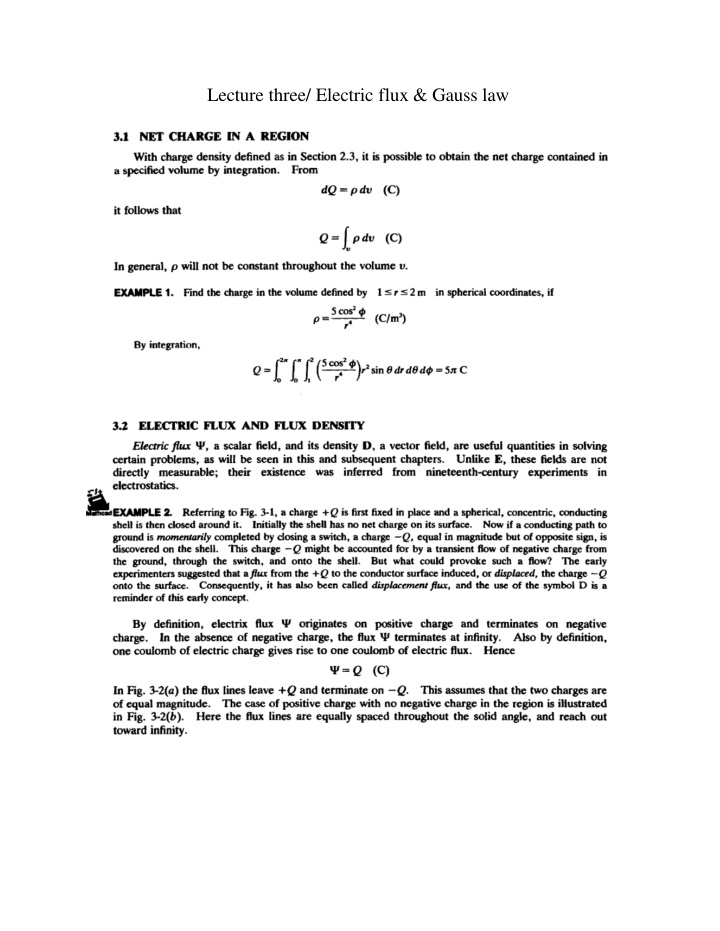
Understanding Electric Flux and Gauss' Law in Physics
Explore the concepts of electric flux, Gauss' law, flux density, and their relationships in electrical charge distributions. Gain insights into how to apply Gauss' law to calculate electric fields using surface integrals.
Download Presentation

Please find below an Image/Link to download the presentation.
The content on the website is provided AS IS for your information and personal use only. It may not be sold, licensed, or shared on other websites without obtaining consent from the author. If you encounter any issues during the download, it is possible that the publisher has removed the file from their server.
You are allowed to download the files provided on this website for personal or commercial use, subject to the condition that they are used lawfully. All files are the property of their respective owners.
The content on the website is provided AS IS for your information and personal use only. It may not be sold, licensed, or shared on other websites without obtaining consent from the author.
E N D
Presentation Transcript
Jlla.3-1 \ I !"\ (b) 3 + Q -....; -Q (a) t'l& 3-Z H in the neighborhood of point P the lines of flux have the direction of the unit vector a (see Fig. 3-3) and if an amount of flux dW crosses the differential area dS, which is a normal to a, then the electric flux density at P is A volume charge distribution of density p (C/m3 is shown enclosed by surface S in Fig. 3-4. Since each coulomb of charge Q has. by definition, one coulomb of flux 'I', it follows that the net flux crossing the closed surfaceS is an exact measure of the net charge enclosed. ) However, the
density D may vary in magnitude and direction from point to point of S; in general , D will not be along the normal to S. If, at the surface element dS, D makes an angle 8 with the normal, then the differential flux crossing dS is given by d'P = D dS cos 8 =D dSa, = D dS The unit vector a, is where dS is the vector surface element, of magnitude dS and direction an. always taken to point out of S , so that d'l! is the amount of flux passing from the interior of S to the exterior of S through dS. D Fig.3-4 3. GAUSS' LAW Gauss' law states that The total flux out of a closed surface is equal to the net charge within the surface. This can be written in integral form as fD dS= Qenc A great deal of valuable information can be obtained from Gauss' law through clever choice of the surface of integration; see Section 3.5. 4. RELATION BE1WEEN FLUX DENSITY AND ELECTRIC FIELD INTENSITY Consider a point charge Q (assumed positive, for simplicity) at the origin (Fig. 3-5). is enclosed by a spherical surface of radius r, then , by symmetry, D due to Q is of constant magnitude over the surface and is everywhere normal to the surface. Q =fD dS=DfdS =D(4.n:r2 If this Gauss' law then gives ) z y Fig. 3-5
from which D =Q/4rrr2 Therefore D =-Qa , . =-Q- a 4rrr2 ' 4.m-2 But, from Section 2.2, the electric field intensity due to Q is Q - - E = a 41rEoT2 , D = It follows that EoE. More generally, for any electric field in an isotropic medium of permittivity E, D=EE Thus, D and E fields will have exactly the same form, since they differ only by a factor which is a constant of the medium. While the electric field E due to a charge configuration is a function of the pennittivity E, the electric fiux density Dis not. advantage will be found in first obtaining D, then converting toE within each dielectric. In problems involving multiple dielectrics a distinct 5. SPECIAL GAUSSIAN SURFACES The surface over which Gauss' law is applied must be closed. but it can be made up of several surface elements. If these surface elements can be selected so that D is either normal or tangential, and if IDI is constant over any element to which D is normal, then the integration becomes very mple. Thus the defining conditions of a special gau.f.fian .'iurface are 1. 2. 3. The surface is closed. At each point of the surface D is either normal or tangential to the surface. D is sectionally constant over that part of the surface where D is normal. Use a special gaussian surface to find D due to a uniform line change p , (C/m). EXAMPLE 3 Take the line charge as the z axis o( cylindrical coordinates (Fig. 3-6). By cylindrical symmetry, D can 0 0
A point charge, Q =30nC, is located at the origin in cartesian coordinates. electric flux density D at (1, 3, -4) m. 3.8. Find the Referring to Fig. 3-12, Q D 4 rR1a" =30x 10- 4 r(26) =(9.18x 10-11) ( ..+3a,.-48 ) C/m2 +3a,.- Vi6 9 4a.) ( v26 or, more conveniently, D =91.8pC/m2 (1, 3 , -4) \D fll 3-ll Two identical uniform line charges lie along the x and y axes with charge densities p ,= 20p.C/m. Obtain D at (3, 3, 3)m. 1be distance from the observation point to either line charge is 3v2m. Considering first the line charge on tbe x axis, 3 . 9. D,_-p ,,-201-1C/m ( 2m', ) - 21r(3v'2m) v'2 and now they axisline charge, D,= p ar'2= = 201-'C/m ( ..+ ) 2m'z 21r(3v'2m) Vi
r < R. Hence from tbe c:ylinder of charge and the result found above will stiU apply to this ring. within the ring, in the plane of the ring, D and E are zero. D - 0 for Since 'II is completely in the radial direction , a slice dz can be taken For all points p - Sre- (C/m3 A charge configuration in cylindrical coordinates is given by . Gauss' law to find D. Use ) Since p is not a function of or z. the flux 'II is completely radial. r constant, the ftux density D must be of constant magnitude. is a closed ript circular cylinder. becomes fL : .[ Sre-z.rdrdq>dz D(2ruL) S.nL(e-z.(- r - r - i)+ l} D(2nrL) D ( I- e-z-(,.:+r +m a, (C/m2 It is also true that, for Then a proper special gaussian surface The integrals over the plane ends vanish, so that Gauss' law Q....-f,_.o dS _..., 2 5 r Hence ) r =2m ' Tbe volume in cylindrical coordinates between charge density p (C/m3 . From Fia.3-16, for r = 4m and contains a uniform Use Gauss' law to find Din aU regions. ) O< r<2m, Q...-D(2m-L) o- o lila 3-16 For 2 :S r :S4m, .npL(,-%- 4) D(21frL) D =;_(r- 4)a. (C / m For r > 4m, 121fpL D(21frL) 6p D = - a, (C/m2) r



![Lec [2] Health promotion](/thumb/274962/lec-2-health-promotion-powerpoint-ppt-presentation.jpg)